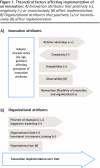Implementation of electronic medical records: theory-informed qualitative study
- PMID: 21998247
- PMCID: PMC3192105
Implementation of electronic medical records: theory-informed qualitative study
Abstract
Objective: To apply the diffusion-of-innovations theory to the examination of factors that are perceived by family physicians as influencing the implementation of electronic medical records (EMRs).
Design: Qualitative study with 2 focus groups 18 months after EMR implementation; participants also took part in a concurrent quantitative study examining EMR implementation and preventive services.
Setting: Toronto, Ont.
Participants: Twelve community-based family physicians.
Methods: We employed a semistructured interview guide. The interviews were audiotaped and transcribed verbatim; 2 researchers independently categorized and coded the transcripts and then met to compare and contrast their findings, category mapping, and interpretations. Findings were then mapped to an existing theoretical framework.
Main findings: Multiple barriers to EMR implementation were described. These included lack of relative advantage for many processes, high complexity of the system, low compatibility with physician needs and past experiences, difficulty with adaptation of the EMR to the organization and adaptation of the organization to the EMR, and lack of organizational slack. Positive factors were the presence of a champion and relative advantages for some processes.
Conclusion: Early EMR implementation experience is consistent with theoretical concepts associated with implementation of innovations. A problematic implementation process helps to explain, at least in part, the lack of improvement in preventive services in our quantitative results.
Objectif: Appliquer la théorie de la diffusion des innovations à l’examen des facteurs qui, selon les médecins de famille, influencent l’introduction des dossiers médicaux électroniques (DMÉ).
Type d’étude: Étude qualitative à l’aide de 2 groupes de discussion, 18 mois après la mise en œuvre des DMÉ; les participants participaient en même temps à une étude quantitative sur les rapports entre l’introduction des DMÉ et les activités préventives.
Lieu de l’étude: Toronto, Ontario.
Participants: Douze médecins de famille de la communauté
Méthodes: On a utilisé un guide d’entrevue semi-structurée. Les entrevues ont été enregistrées sur ruban magnétique et transcrites mot à mot; 2 chercheurs ont, chacun de leur côté, codé et classé par catégories les transcrits, pour ensuite comparer et confronter leurs observations, leur classement en catégories et leurs interprétations. Leurs observations ont été ensuite appliquées à un cadre théorique existant.
Principales observations: On a décrit plusieurs obstacles à l’introduction des DMÉ, dont le manque d’avantages relatifs pour plusieurs processus, la grande complexité du système, le peu de compatibilité avec les besoins et les expériences antérieures des médecins, la difficulté d’adapter le DMR à l’organisation et d’adapter l’organisation aux DMÉ, et l’absence de flexibilité de l’organisation. Les facteurs positifs étaient la présence d’un champion et des avantages relatifs pour certains processus.
Conclusion: Les premières données sur l’introduction des DMÉ sont compatibles avec les concepts théoriques associés à la mise en œuvre d’innovations. Un processus de mise en place problématique peut expliquer, au moins en partie, le peu d’amélioration des services préventifs qu’indiquent nos résultats quantitatifs.
Figures
Similar articles
-
Implementation of electronic medical records: effect on the provision of preventive services in a pay-for-performance environment.Can Fam Physician. 2011 Oct;57(10):e381-9. Can Fam Physician. 2011. PMID: 21998246 Free PMC article.
-
Implementing electronic health records: Key factors in primary care.Can Fam Physician. 2008 May;54(5):730-6. Can Fam Physician. 2008. PMID: 18474707 Free PMC article.
-
Estimating impacts on safety caused by the introduction of electronic medical records in primary care.Inform Prim Care. 2004;12(4):235-42. doi: 10.14236/jhi.v12i4.131. Inform Prim Care. 2004. PMID: 15808025
-
Implementation of the electronic medical record: the team approach.Comput Nurs. 2001 Mar-Apr;19(2):47-55. Comput Nurs. 2001. PMID: 11280148 Review.
-
Best practices in EMR implementation: a systematic review.AMIA Annu Symp Proc. 2006;2006:982. AMIA Annu Symp Proc. 2006. PMID: 17238601 Free PMC article.
Cited by
-
The Development and Evaluation of an Electronic Health Record Efficiency Workshop for Providers.Appl Clin Inform. 2020 Mar;11(2):336-341. doi: 10.1055/s-0040-1709509. Epub 2020 May 6. Appl Clin Inform. 2020. PMID: 32375195 Free PMC article.
-
Electronic Health Record Challenges, Workarounds, and Solutions Observed in Practices Integrating Behavioral Health and Primary Care.J Am Board Fam Med. 2015 Sep-Oct;28 Suppl 1(Suppl 1):S63-72. doi: 10.3122/jabfm.2015.S1.150133. J Am Board Fam Med. 2015. PMID: 26359473 Free PMC article.
-
Primary care physicians' attitudes to the adoption of electronic medical records: a systematic review and evidence synthesis using the clinical adoption framework.BMC Med Inform Decis Mak. 2018 Nov 13;18(1):101. doi: 10.1186/s12911-018-0703-x. BMC Med Inform Decis Mak. 2018. PMID: 30424758 Free PMC article.
-
Implementation of targeted screening for poverty in a large primary care team in Toronto, Canada: a feasibility study.BMC Fam Pract. 2021 Sep 30;22(1):194. doi: 10.1186/s12875-021-01514-9. BMC Fam Pract. 2021. PMID: 34592935 Free PMC article.
-
Implementation of electronic medical records: effect on the provision of preventive services in a pay-for-performance environment.Can Fam Physician. 2011 Oct;57(10):e381-9. Can Fam Physician. 2011. PMID: 21998246 Free PMC article.
References
-
- Jha AK, Perlin JB, Kizer KW, Dudley RA. Effect of the transformation of the Veterans Affairs Health Care System on the quality of care. N Engl J Med. 2003;348(22):2218–27. - PubMed
-
- Garg AX, Adhikari NK, McDonald H, Rosas-Arellano MP, Devereaux PJ, Beyene J, et al. Effects of computerized clinical decision support systems on practitioner performance and patient outcomes: a systematic review. JAMA. 2005;293(10):1223–38. - PubMed
-
- Eccles M, Grimshaw J, Steen N, Parkin D, Purves I, McColl E, et al. The design and analysis of a randomized controlled trial to evaluate computerized decision support in primary care: the COGENT study. Fam Pract. 2000;17(2):180–6. - PubMed
Publication types
MeSH terms
LinkOut - more resources
Full Text Sources
Miscellaneous

